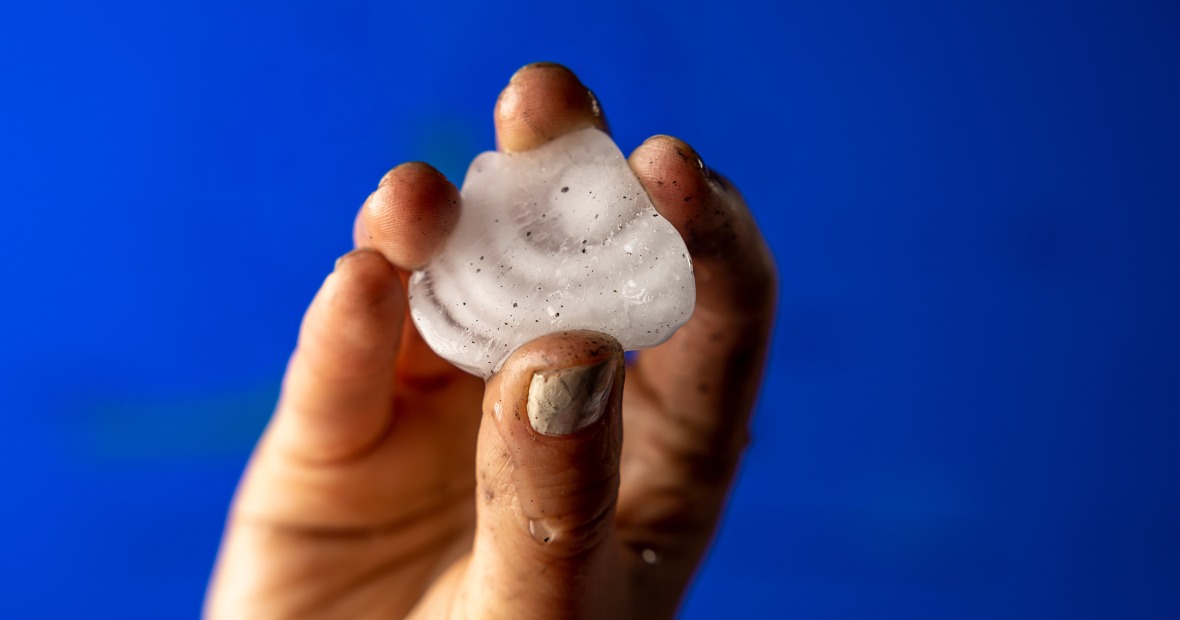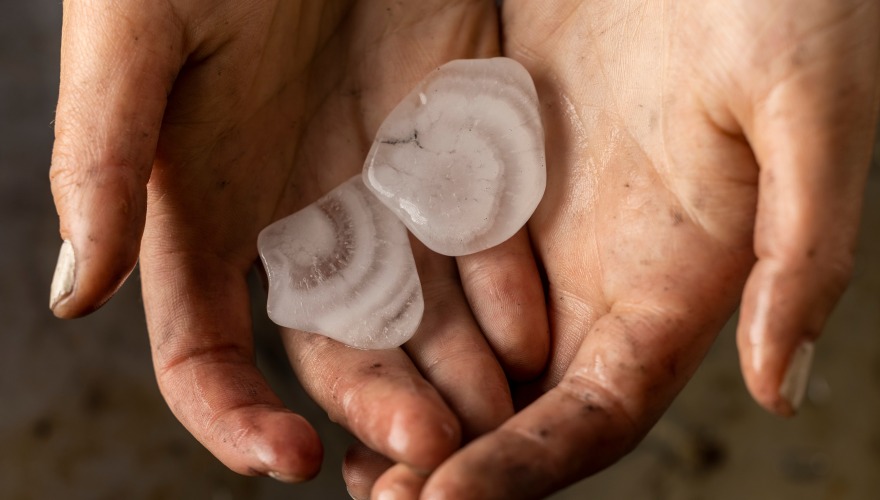Inquiry-Led: What The Hail?
Growing up, one of my favorite books was Cloudy with a Chance of Meatballs, written by Judi Barrett and spectacularly illustrated by Ron Barrett. The book tells the story of an imaginary town called Chewandswallow, where residents receive their food in the form of weather. Their meals come from the sky three times a day — orange juice rain and burger storms, mashed potato clouds and apple pie precipitation. This arrangement works well for the people of Chewandswallow until the weather takes a turn for the worse.
As the size of the food grows larger and the menu grows less predictable and even less appetizing, the inclement grocery conditions cause all manner of property damage. Finally, the residents of Chewandswallow decide to build ships out of giant PB&J sandwiches and relocate to a new land — one where food appears only on the shelves of supermarkets.
On Sunday, May 7, I thought about Chewandswallow as clementine-sized hail fell from the sky.
During the 15-minute hailstorm, my car’s windshield was cataclysmically cracked. My left taillight was shattered. My car is still freckled with about a hundred dents. And others in Grinnell had it much worse. The Safelite in Marshalltown was booked out into June with windshield replacements. Hail broke through the roof of the Walmart. It led to ceiling leaks in the College Dining Hall. And, for weeks, my neighbor covered their car with a tarp to keep rain from entering the shattered back window.
I’d seen hail before. But never like this.
Over the following days, as I dealt with insurance agents, scheduling auto repair appointments, and the temporary loss of a car, perhaps the single most frustrating experience was the following realization:
I have no idea how hail happens.
What is hail? How does it form? And how do we end up getting pelted with (truly) meatball-sized hail?
If you weren’t curious before May 7, you probably are now.
Storms 101
The first thing I needed to understand was the storm conditions that produce hail. What makes a hailstorm different from rain or snow? Basically, I needed a Storms 101 crash course.
For this, I turned to the National Severe Storms Laboratory at NOAA, the National Oceanic and Atmospheric Administration. NOAA’s website is an absolute goldmine of severe weather information, measured and explained by the nation’s leading atmospheric scientists. Was it overwhelming? Yes. Did I persevere? Indeed.
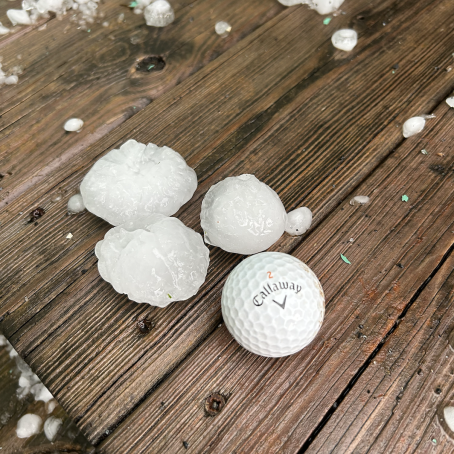
The first thing I learned is that every single storm starts with an updraft.
Basically, air near the surface of the Earth becomes warmer than the air above it, and, because warmer air is less dense (its molecules are less tightly packed together), it is more buoyant than the cooler air above it. As the warm air rises through the atmosphere, it reaches still cooler altitudes. There, water vapor condenses to form liquid water, releasing more heat. All this warm, rising air is the updraft.
What exactly causes an updraft? I couldn’t parse the internet’s answers, so I reached out to Dave Rexroth, chief meteorologist at WXYZ Detroit. He’s not only my hometown weatherman — he’s a family friend and the biggest celebrity to attend my eighth-grade confirmation service.
“Updrafts are the energy source for storms,” explains Rexroth. “The stronger they are, the more dangerous the storm. Updraft strength is caused by many factors that influence available instability and lift.”
He went on to explain that a more unstable atmosphere drives stronger updrafts. The more quickly air in the environment cools with height, the more likely the storm is to be warmer than its environment and to keep rising and strengthening. This rate contributes to something called CAPE — Convective Available Potential Energy. “CAPE is the fuel for the storm. Lift is the spark that ignites the fuel,” Rexroth says. This lift can be caused by fronts and troughs that force air to converge and be lifted.
Imagine, if you will, two tectonic plates colliding, with one plate being pushed down while the other buckles upward to form a mountain range. Now imagine that those plates are made up of masses of air at two different temperatures. Rather than a mountain range, we get a storm.
In the spirit of symmetry, storms don’t only have an updraft. They also possess something called (you guessed it) a downdraft. In short, when the force of gravity acting on condensed water droplets becomes stronger than the updraft that is supporting them, they fall to the Earth as precipitation. When any precipitation falls, the movement produces a downdraft — a downward wind.
Rexroth explains that the severity and type of a storm depend on the strength of these upward and downward drafts. For example, an ordinary rain shower is produced by a weak updraft and a weak downdraft, whereas a strong updraft and weak downdraft may result in flash floods.
A Hailstone Is Born
I’ve received (and now imparted) a crash course in storm formation. Up next on the agenda? Hail.
According to NOAA, a storm must have a very strong updraft for hail to form. And now that I know what an updraft is, this makes sense.
Basically, a strong updraft carries rain droplets even higher into the atmosphere – into freezing altitudes. In these cold regions, water droplets may freeze and form a hailstone’s nucleus. When this embryo collides with other supercooled droplets, they freeze to its surface and the hailstone grows. As Rexroth puts it, “The bigger, taller, and stronger the storm is, the more likely it is to have hail in the first place.”
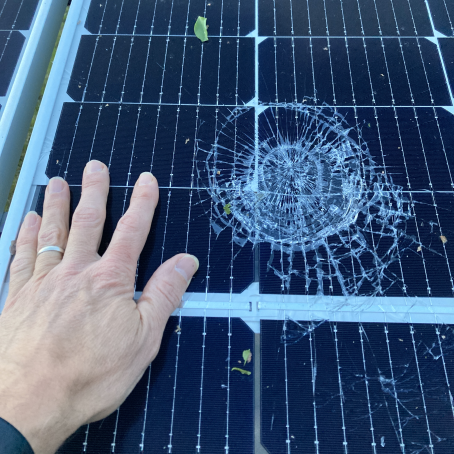
This all checks out, but it’s still unclear how we can end up with golf ball–sized hailstones. Why does a hailstorm sometimes consist of a fine sprinkle and other times of a nightmare at the batting cages?
To answer this, I reached out to KCCI meteorologist Trey Fulbright. He’d reported on the Iowa hailstorms. If anyone could explain what had happened, I hoped it would be him.
He did not disappoint. “Updraft strength and residence time in the thunderstorm cloud determines hail size,” Fulbright explains. “According to NOAA, golf ball–sized hail would require an updraft speed of 64 mph.”
The more time that a hailstone spends being tossed about within a storm, the more droplets it will collide with, and the larger it will grow.
Essentially, Fulbright explains, a strong updraft competes with the force of gravity acting on growing hailstones. As hailstones are pushed into colder pockets of the atmosphere by updrafts, begin to fall under the force of gravity, and are caught up in strong winds all over again, they continue to grow. Strong updrafts buoy the hailstone to spend a longer time colliding with other droplets before it falls to the Earth’s surface.
Winds that blow horizontally across the storm cloud are also important for hail formation, Fulbright adds. These winds create something known as speed shear and “allow the hailstone to remain at an ideal altitude and temperature, where supercooled water drops still exist and can grow around the hail embryo.” If the hailstone were lofted too high into the atmosphere, it would be too cold for new layers to fuse.
As I spoke with neighbors and friends about the hailstorm, one of the most common remarks was how long the deluge had lasted. The 15-minute pelting felt unusually long for a hail burst. Was it really abnormal? Fulbright answers:
“The length of hail burst is typically a few minutes but can be up to 15 minutes. It really depends on how fast the storm cell is moving, which is dependent on the speed of the wind flow in the atmosphere.”
So here’s the formula: The May 7 storm had had a strong enough updraft, weak enough downdraft, fast enough shear, and slow enough movement to produce big, honking, window-cracking hailstones for nearly 15 minutes.
Looking for Layers
There was one more thing I needed to do before I finished my hail investigation.
The idea for the task originated early in my research for this piece, during correspondence with Peter Jacobson, professor of biology.
Jacobson had explained that there are two types of hailstone growth: wet and dry. The type of growth that occurs depends on just how cold it is at the altitude where the hailstone is forming.
What’s particularly cool about the two growth types is that they produce visibly distinct hail.
During wet growth, the air temperature is below freezing but not extremely cold. So, when a water droplet collides with the hailstone nucleus, it doesn’t immediately freeze. Instead, the droplet fuses slowly, allowing air bubbles to escape and producing a glob of clear ice on the hailstone’s surface.
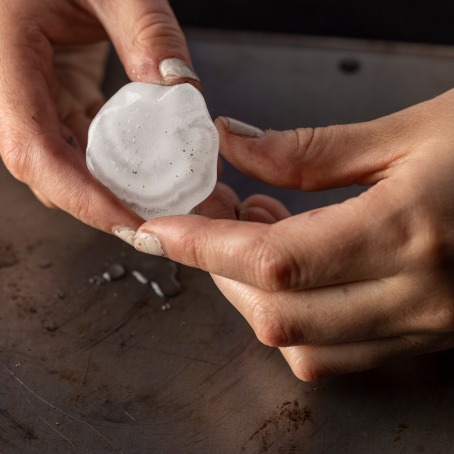
In dry growth, on the other hand, the air temperature is way below freezing. It’s so cold, in fact, that a supercooled water droplet immediately freezes when it collides with a hailstone. In this case, the freezing happens so fast that air bubbles have no time to escape, and the ice droplets remain cloudy.
In the weeks following my conversation with Jacobson, as I learned about updrafts and CAPE and cumulonimbus clouds, I kept wondering:
If the cloudiness of water droplets is determined by the ambient temperature, and if the temperature is determined by the hailstone’s altitude, could I map a hailstone’s journey through the atmosphere just by looking at its layers?
Cut in half, would the stone display rings that could be used (like a tree trunk) to date its formation?
There was only one way to find out.
Fortunately, one of my coworkers had saved a hailstone from the storm.
An Excerpt from the What The Hail Screenplay
EXT. CONFERENCE ROOM – MIDDAY
We open on a conference room in a modestly furnished office building. A young woman in a lab coat kneels at a table and holds a kitchen knife over a candle’s flame. We see a man standing at the other end of the table, camera in hand.
Anika Jane
I think we’re ready for the specimen. Can you hold this?
The photographer takes the knife, keeping it poised over the flame. Soot darkens the blade. Anika Jane sprints out of the room.
She returns, moments later, with a small Tupperware container in hand. A sticky note is attached to the container. “Hail! Not an ice cube! Xoxo AJ,” the note reads.
Like a Hot Knife Through Hail
I pull on extra-puffy ski mittens and, as though they are lab gloves, carefully remove the semi-spherical hailstone from the container.
I pull the knife from the flame. Pinning the hailstone to a stainless steel cookie sheet, I press the blade to the ice. Steam rises from the stone, and water begins to pool at its base. The knife cuts halfway through the hailstone before it meets resistance. I quickly reheat the blade and, sawing gently, the hailstone splits in two.
Immediately, I can see the bull’s-eye-like pattern that forms the hailstone’s cross-section. HAIL YES.
A clear nucleus is surrounded by a cloudy ring, then a narrow transparent layer, a large belt of cloudy ice broken with a fine line of clear, and finally, a clear outer rim. Wet growth, dry growth, wet growth, dry, wet, dry, wet. This is the hailstone’s story.
As the ice melts and the halves fade to flat discs, the layers are even more clearly visible. What’s more, you can see the individual water droplets that collided and fused to form the hailstone. It’s not a golf ball — it’s a handful of marbles.
Before the last bit of hail melts into oblivion, I run around the office for a quick show and tell. The hail becomes water in my red palms.
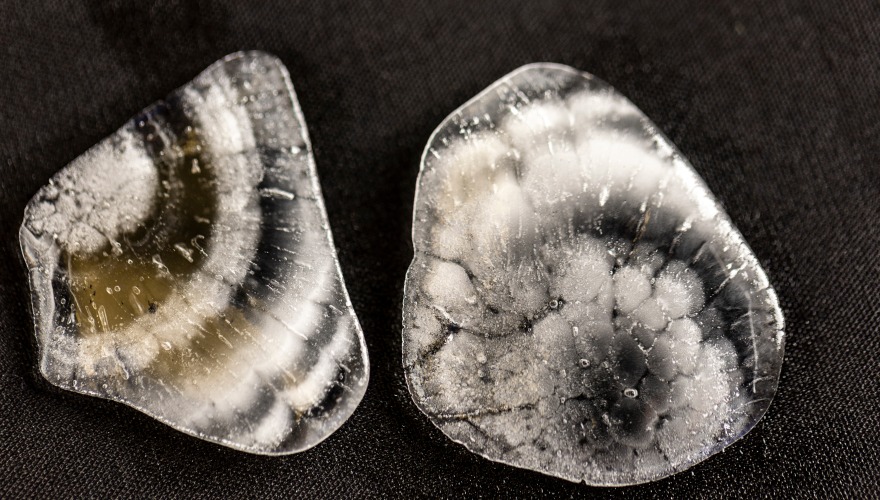
An Uneasy Peace
It’s hard to say whether changing climates will produce more frequent and damaging hailstorms. It’s more likely that the storms will get harder to predict.
As I’ve learned, the formation of hail (and its size) depends on the interaction of factors such as temperature, water availability, and winds. “Climate change can of course affect all of these,” says Jacobson. “A warmer atmosphere holds more water, and turbulent conditions may be more likely and stronger. These factors would seem to favor more frequent and larger hail events – and larger stones.” But a warmer atmosphere can also speed up the melting rate of hail, Jacobson adds. This would hinder hail formation. “I know folks have been trying to model these dynamics and make predictions, but I believe it has been a challenging exercise.”
So I don’t know whether we’ll see a hailstorm this severe in the future. I hope not — for my car’s sake if nothing else.
But next time, if it comes, I’m hoping I can preserve some of my dignity with knowledge. What’s the saying? The severe weather event you know is better than the one you don’t.

